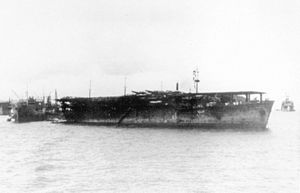Nitta Maru

Chūyō at anchor, Truk, 18 May 1943
|
|
| History | |
|---|---|
|
|
|
| Name: | Nitta Maru |
| Operator: |
|
| Builder: | Mitsubishi Shipbuilding & Engineering Co., Nagasaki, Japan |
| Yard number: | 750 |
| Laid down: | 9 May 1938 |
| Launched: | 20 May 1939 |
| Maiden voyage: | 23 March 1940 |
| Fate: | Transferred to the Imperial Japanese Navy, 1942 |
|
|
|
| Commissioned: | 25 November 1942 |
| Renamed: | Chūyō, 31 August 1942 |
| Struck: | 5 February 1944 |
| Fate: | Sunk by the submarine USS Sailfish, 4 December 1943 |
| General characteristics (as converted) | |
| Class and type: | Taiyō-class escort carrier |
| Displacement: |
|
| Length: | 180.2 m (591 ft 4 in) (o/a) |
| Beam: | 22.5 m (73 ft 10 in) |
| Draft: | 7.7 m (25 ft 5 in) |
| Installed power: |
|
| Propulsion: |
|
| Speed: | 21 knots (39 km/h; 24 mph) |
| Range: | 6,500 or 8,500 nmi (12,000 or 15,700 km; 7,500 or 9,800 mi) at 18 knots (33 km/h; 21 mph) |
| Complement: | 850 |
| Armament: |
|
| Aircraft carried: | 30 |
Chūyō (冲鷹, "hawk which soars") was a Taiyō-class escort carrier originally built as Nitta Maru (新田 丸), the first of her class of three passenger-cargo liners built in Japan during the late 1930s. She was requisitioned by the Imperial Japanese Navy (IJN) in late 1941 and was converted into an escort carrier in 1942. She spent most of her service ferrying aircraft, cargo and passengers to Truk until she was torpedoed and sunk by an American submarine in late 1943 with heavy loss of life.
Nitta Maru was the lead ship of her class and was built by Mitsubishi Shipbuilding & Engineering Co. at their Nagasaki shipyard for Nippon Yusen Kaisha (NYK). She was laid down on 9 May 1938 as yard number 750, launched on 20 May 1939 and completed on 23 March 1940. The IJN subsidized all three Nitta Maru-class ships for possible conversion into auxiliary aircraft carriers. The ships were intended to upgrade NYK's passenger service to Europe and it was reported that Nitta Maru was the first ship to be fully air conditioned in the passenger quarters. The ships had accommodation for 285 passengers (127 first class, 88 second and 70 third). The start of World War II in September 1939 restricted them to the Pacific and they served on the San Francisco run until the Japanese Government declared a ban on all voyages to the United States in August 1941.
The 17,163-gross register ton (GRT) vessel had a length of 170.0 meters (557.8 ft), a beam of 22.5 meters (73.8 ft) and a depth of hold of 12.4 meters (40.7 ft). She had a net tonnage of 9,397 and a cargo capacity of 11,800 tons. The ship was powered by two sets of geared steam turbines made by the shipbuilder, each driving one propeller shaft, using steam produced by four water-tube boilers. The turbines were rated at a total of 25,200 shaft horsepower (18,800 kW) that gave her an average speed of 19 knots (35 km/h; 22 mph) and a maximum speed of 22.2 knots (41.1 km/h; 25.5 mph).
...
Wikipedia
